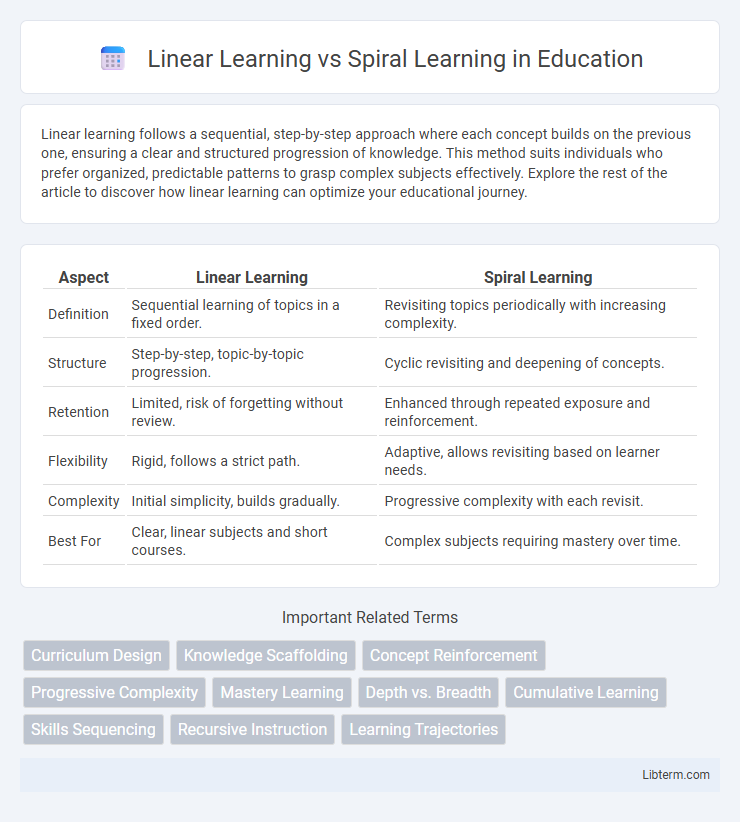Linear learning follows a sequential, step-by-step approach where each concept builds on the previous one, ensuring a clear and structured progression of knowledge. This method suits individuals who prefer organized, predictable patterns to grasp complex subjects effectively. Explore the rest of the article to discover how linear learning can optimize your educational journey.
Table of Comparison
| Aspect | Linear Learning | Spiral Learning |
|---|---|---|
| Definition | Sequential learning of topics in a fixed order. | Revisiting topics periodically with increasing complexity. |
| Structure | Step-by-step, topic-by-topic progression. | Cyclic revisiting and deepening of concepts. |
| Retention | Limited, risk of forgetting without review. | Enhanced through repeated exposure and reinforcement. |
| Flexibility | Rigid, follows a strict path. | Adaptive, allows revisiting based on learner needs. |
| Complexity | Initial simplicity, builds gradually. | Progressive complexity with each revisit. |
| Best For | Clear, linear subjects and short courses. | Complex subjects requiring mastery over time. |
Understanding Linear Learning
Linear learning follows a sequential path where concepts are taught in a fixed order, ensuring foundational knowledge is established before progressing to more complex topics. This structured approach aids in building clear, step-by-step understanding and reduces cognitive overload by limiting the scope to one topic at a time. Often used in traditional education, linear learning is effective for subjects requiring mastery of prerequisite skills, such as mathematics and language acquisition.
Defining Spiral Learning
Spiral learning is an instructional approach where key concepts are revisited and expanded upon progressively over time, allowing deeper understanding through repeated exposure. Unlike linear learning, which follows a sequential and cumulative path, spiral learning emphasizes cyclic reinforcement and integration of topics at increasing levels of complexity. This method enhances retention, adaptability, and mastery by connecting prior knowledge with new information in a structured yet flexible framework.
Key Differences Between Linear and Spiral Learning
Linear learning follows a sequential, step-by-step progression, emphasizing mastering one concept before moving to the next, which supports structured knowledge acquisition and clarity. Spiral learning revisits topics repeatedly over time, deepening understanding through increasing complexity and reinforcing connections between concepts. Key differences include the linear model's emphasis on completion of units before advancement versus the spiral approach's cyclical review, promoting long-term retention and cognitive development.
Advantages of Linear Learning
Linear learning offers a structured and sequential approach, ensuring mastery of foundational concepts before progressing to more complex topics, which enhances retention and reduces cognitive overload. This method simplifies curriculum design, making it easier for educators to track student progress and identify gaps. Consistency and clarity in linear learning paths provide learners with a straightforward framework that boosts confidence and motivation.
Benefits of Spiral Learning
Spiral learning enhances long-term retention by revisiting key concepts at increasing levels of complexity, allowing learners to build on prior knowledge effectively. This method promotes deeper understanding through reinforcement and connection of ideas over time, reducing cognitive overload. It supports adaptive learning by catering to individual progress, making it especially beneficial in subjects requiring layered comprehension like mathematics and language acquisition.
Challenges of Linear and Spiral Approaches
Linear learning often faces challenges due to its rigid, step-by-step progression that can limit flexibility and fail to accommodate diverse learning paces or prior knowledge. Spiral learning may encounter difficulties related to learner confusion or redundancy, as revisiting topics multiple times requires careful curriculum design to ensure meaningful depth without repetition. Both approaches demand tailored instructional strategies to address individual learner needs and optimize knowledge retention.
Impact on Student Retention and Mastery
Linear learning, following a sequential progression, often facilitates clarity in concept acquisition but may limit long-term retention due to minimal content revisitation. In contrast, spiral learning revisits key topics with increasing complexity, reinforcing understanding and significantly improving student retention and mastery. Studies reveal that spiral learning's iterative approach enhances cognitive connections, leading to deeper comprehension and sustained knowledge retention over time.
Application in Curriculum Design
Linear learning structures curriculum in a sequential manner, ensuring foundational concepts are mastered before progressing to complex topics, ideal for subjects requiring step-by-step skill acquisition like mathematics. Spiral learning revisits core concepts multiple times across the curriculum, each revisit expanding on complexity and reinforcing retention, beneficial in interdisciplinary studies such as language arts or science. Applying these strategies in curriculum design enhances knowledge retention and skill mastery by aligning learning progression with subject complexity and learner cognitive development.
Case Studies: Real-World Examples
Case studies in education reveal that linear learning excels in subjects requiring step-by-step mastery, such as mathematics, where straightforward progression builds foundational skills systematically. Spiral learning shows significant effectiveness in language acquisition, as revisiting topics at increasing complexity enhances long-term retention and conceptual understanding. Analysis of classroom implementations demonstrates spiral learning's adaptability in dynamic environments, contrasting with linear learning's structured approach beneficial for standardized testing success.
Choosing the Right Approach for Your Learners
Selecting the right instructional approach depends on learner needs and content complexity, where linear learning offers structured, step-by-step progression ideal for foundational knowledge. Spiral learning revisits topics repeatedly with increasing depth, enhancing retention and critical thinking for complex or cumulative subjects. Tailoring these methods to individual learning styles and educational goals ensures more effective skill development and knowledge mastery.
Linear Learning Infographic

 libterm.com
libterm.com